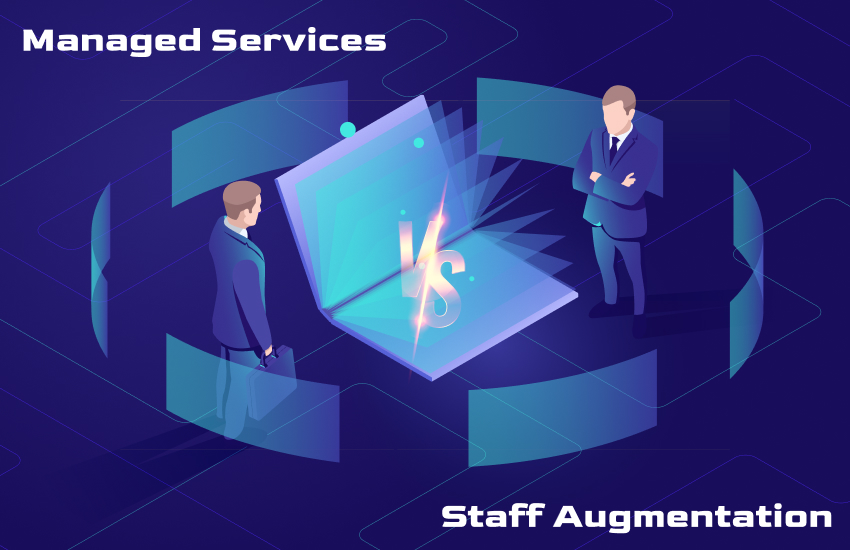Choosing Between Managed Services and Staff Augmentation

IT companies all over the world have to deal with tough competition. The IT market worldwide grew by 11.6% per year, from $8,384.32 billion in 2021 to $9,358.51 billion in 2022. Because the IT industry is so high-stakes, small and large businesses have to react quickly to new problems. This requires a new way to handle teams.
Businesses are making digital products like new websites, apps, and other tools. To do this, you need to keep up with how quickly technology changes and the growing need to hire a dedicated development team.
These businesses specialize in a single area and need more help with their projects. This is where they can think about either managed IT staff expansion or managed IT services.
You may inquire about "Which model is superior when comparing IT staff augmentation vs. managed IT services." Then, pick offshore dedicated coders who can help your business. Hiring a dedicated programming team is not a one-size-fits-all process.
When deciding between managed services vs staff augmentation for your next project, several factors come into play. Both staff augmentation and managed services have distinct advantages, and the choice depends on your project requirements, goals, and organizational preferences. To assist you in making a well-informed choice, below is a breakdown:
What is Staff Augmentation?
Staff augmentation, a form of IT outsourcing, empowers companies to augment their teams with skilled professionals for specific projects or tasks. This temporary arrangement, which concludes upon project completion, is an ideal solution when immediate full-time hiring is not necessary. Akkenna, a leader in the industry, stands ready to provide top-notch staff augmentation services, ensuring tailored expertise to enhance project success.
There are many business benefits to hiring extra IT staff, such as getting more IT resources without making long-term commitments, hiring people for short periods, extending a focused software development team, and so on. Staff addition is a cheaper way to get work done than hiring full-time workers, who take more time and effort.
Types of Staff Augmentation
When it comes to hiring experienced dedicated developers, there are a few different types of candidates that you should be aware of when you embrace an IT staff augmentation hiring plan.
1.Short Term
For short periods, this is meant to help you when you need to add strength to your present staff. For a short time, between a few weeks and a few months, this will cause your ability to grow.
2.Long-term
The term "staff augmentation" refers to any project that requires more workers for a lengthy period, often for six months or longer.
3.Highly Experienced
When the stakes are high, you'll need staff with a lot of knowledge. For a job that needs more skill, you would need to hire someone with experience. Partner companies that do outsourcing that have a lot of experience usually work in IT or software development.
4.Skills-based
Skill-based staff addition is the best way to get the help you need for a project. Here, you hire people based on their skills and help the ones you already have (in-house) work well. For example, skill-based staff augmentation can help with small chores that need specific skills, like typing or data entry.
5.Temporary Staff Augmentation:
Bringing in temporary professionals for a specific project or to fill a short-term skill gap.
6.Contract-Based Staff Augmentation:
Engaging professionals on a contract basis to work on projects or provide specialized skills for a defined period.
7.Onshore Staff Augmentation:
Engaging professionals located within the same country as the hiring company, ensuring cultural alignment and accessibility.
8.Offshore Staff Augmentation:
Utilizing professionals located in a different country, often chosen for cost-effectiveness or to tap into a global talent pool.
Benefits of Staff Augmentations:
Staff augmentation and management services can help your projects reach their full potential. Staff augmentation is a strategic ally in the ever-changing world of IT solutions because it provides flexibility and customized knowledge. This opening talks about the advantages of combining staff augmentation in a way that makes the project success unmatched.
Flexibility and Control:
• Ideal for projects where you want direct control over tasks and team members.
• Offers flexibility to scale the team up or down based on project demands.
Skill Set Matching:
• Enables you to specifically choose and augment your team with professionals possessing the exact skills needed for your project.
Cost Efficiency:
• Can be more cost-effective than hiring full-time employees, especially for short-term or specialized projects.
Quick Onboarding:
• Faster onboarding as the augmented staff is integrated into your existing team and processes.
When is it appropriate to seek IT staff augmentation services, & why?
IT staff augmentation services shine when your project requires specialized skills not readily available in your existing team. This approach is ideal for obtaining temporary support in specific project phases, facilitating rapid team scaling, or enhancing in-house capabilities with external expertise. The flexibility of staff augmentation allows access to skilled professionals without the long-term commitment linked to full-time hires, presenting a distinct advantage in the context of managed services vs staff augmentation considerations.
Managed Services
Experience comprehensive coverage for every facet of your IT system with Akkenna. From quick, one-time requests to around-the-clock monitoring and maintenance, Akkenna will provide managed IT services tailored to your business needs. This model proves invaluable for businesses aiming to enhance their IT capabilities or address skill gaps within their existing IT departments.
It's up to you whether you want to use these services with a public or private cloud system.
In the IT field, most managed service providers charge flat rates or monthly fees. In this case, you agree to pay the MSP a fee every month for their help. Most of the time, a managed services agreement and service-level agreement (SLA) spell out the terms of this deal.
The foreign software company would sign a contract that spelled out the exact tasks they would do, how much they would charge, and how they would measure how well their services were doing.
Types of Managed Service
Managed IT services encompass a range of offerings to ensure the efficient and secure management of an organization's IT infrastructure. Some examples of managed IT services are as follows:
Managed Security Services (MSS):
Includes services like threat detection, vulnerability assessments, and security monitoring to safeguard against cyber threats.
Managed Network Services:
Involves the management and optimization of network infrastructure, including routers, switches, and firewalls, to ensure reliable connectivity.
Managed Cloud Services:
Encompasses the management of cloud infrastructure, data storage, and applications, ensuring optimal performance, security, and scalability.
Managed Data Backup and Recovery:
Involves regular data backups, storage management, and recovery solutions to protect against data loss and ensure business continuity.
Managed Hosting Services:
Provides outsourced hosting solutions, managing servers, hardware, and associated infrastructure to ensure high availability and performance.
Managed Endpoint Security:
Focuses on securing end-user devices (desktops, laptops, mobile devices) against security threats through antivirus, anti-malware, and endpoint protection measures.
Managed IT Support Services:
Offers ongoing IT support, including helpdesk services, troubleshooting, and issue resolution for end-users.
Managed Unified Communications:
Integrates and manages communication tools such as voice, video, messaging, and collaboration platforms to enhance connectivity and productivity.
Managed Disaster Recovery:
Ensures the development and execution of comprehensive disaster recovery plans to minimize downtime and data loss in the event of a disaster.
Managed Print Services:
Involves the outsourcing of print-related tasks, including maintenance, supplies, and optimization of print infrastructure for cost efficiency.
Managed Database Services:
Encompasses the administration, optimization, and security of databases to ensure data integrity, performance, and accessibility.
Managed Mobility Services:
Focuses on managing mobile devices, applications, and security to support a mobile workforce effectively.
Managed Compliance and Regulatory Services:
Addresses compliance with industry regulations and standards, providing services to ensure data protection and legal adherence.
Managed AI and Analytics Services:
Includes services related to the implementation, optimization, and management of artificial intelligence and analytics solutions for data-driven insights.
Benefits of Managed Services
Unlock the transformative Benefits of Managed Services as we delve into a comprehensive approach to IT management. Experience enhanced efficiency, proactive problem resolution, and a strategic IT partnership tailored to elevate your business operations and outcomes. Discover how embracing managed services can revolutionize your organizational landscape.
Cost Savings:
Managed IT services provide a cost-effective solution by eliminating the need for in-house IT personnel and the associated expenses such as salaries, benefits, and training. The subscription-based model allows organizations to budget more predictably, with fixed monthly costs.
Proactive Maintenance and Support:
With managed services, IT issues are often identified and resolved before they impact operations. Regular monitoring, maintenance, and updates ensure that systems are running efficiently, reducing downtime and enhancing overall system reliability.
Access to Expertise:
Managed service providers (MSPs) offer access to a team of skilled IT professionals with diverse expertise. This ensures that businesses benefit from the latest industry knowledge, technologies, and best practices without the need for in-house training and recruitment.
Focus on Core Business Objectives:
Outsourcing IT management allows organizations to redirect their focus and resources towards core business functions. By letting experts handle IT infrastructure, businesses can concentrate on strategic goals, innovation, and improving overall operational efficiency.
Enhanced Security and Compliance:
Managed IT services include robust security measures to safeguard against cyber threats. Regular security assessments, updates, and proactive monitoring help organizations stay ahead of potential risks. Additionally, managed service providers often assist in maintaining compliance with industry regulations and data protection standards.
When should managed IT services be considered, and why?
Managed IT services should be considered when an organization seeks to streamline its IT operations, enhance cybersecurity, ensure consistent system performance, and access a diverse skill set without the burden of internal management. This strategic move is particularly beneficial for those aiming to optimize costs, boost efficiency, and focus on core business functions while entrusting the complexities of IT management to expert service providers.
Primary Difference Between Staff Augmentation And Managed Services
Flexibility and Control:
• Staff Augmentation: Offers greater flexibility and control over project tasks and team management.
• Managed IT Services: Involves relinquishing day-to-day control to a third-party provider, focusing on overall project outcomes.
Responsibility and Oversight:
• Staff Augmentation: Requires the client to manage and oversee the augmented team's tasks and responsibilities.
• Managed IT Services: Entrusts the service provider with comprehensive responsibility for project deliverables, timelines, and performance.
Duration and Scalability:
• Staff Augmentation: Ideal for short-term or specific skill needs; easily scalable for temporary project phases.
• Managed IT Services: Suited for long-term projects with ongoing management needs; scalability is typically more structured.
Expertise Access:
• Staff Augmentation: Allows organizations to choose professionals with specific skills tailored to project requirements.
• Managed IT Services: Provides access to a broader pool of expertise through the service provider's team, covering various IT functions.
Cost Structure:
• Staff Augmentation: Often more cost-effective for short-term projects, as clients pay for specific skills and hours worked.
• Managed IT Services: Involves a predictable, subscription-based cost structure, simplifying budgeting and financial planning.
Conclusion:
In conclusion, the critical decision between IT Staff Augmentation and managed services significantly relies on your project's unique needs and objectives. IT Staff Augmentation, with its flexibility and control, proves advantageous for short-term initiatives requiring specialized skills. Conversely, managed services offer comprehensive end-to-end support, enabling organizations to delegate IT management to external experts for a proactive approach. At Akkenna, we excel in providing both Managed IT Services and Staff Augmentation Services, ensuring tailored solutions for your specific requirements. Contact us to discover the perfect blend that aligns seamlessly with your project's complexity, budget considerations, and in-house expertise, paving the way for successful and efficient project execution in line with your overarching organizational goals.

Muthukumar M
Digital Marketing Executive at Akkenna, specializing in developing effective strategies to drive online visibility and engagement. Expertise in SEO, social media campaigns, and leveraging data-driven insights to achieve business goals.